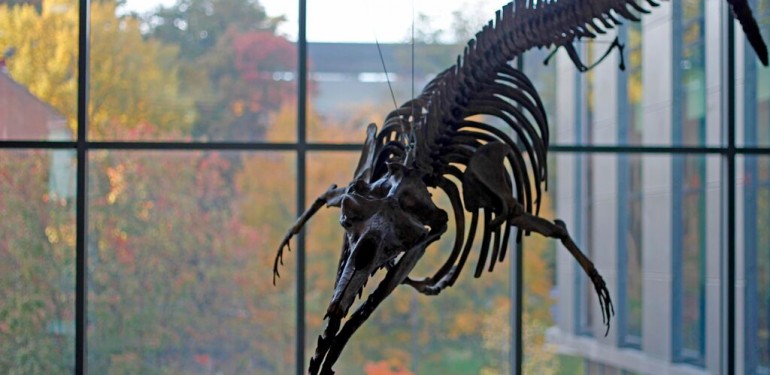(Photo credit: Claire Cecil/Fourth Estate)
Mason students can now get a glimpse of the past just by walking through Exploratory Hall.
The university has received the fossil of a Zygorhiza kochii, an ancient relative to the modern-day whale, from the Smithsonian National Museum of Natural History.
Mark Uhen, a professor from the College of Science’s atmospheric, oceanic and Earth sciences department, spearheaded the initiative. He said he has been studying these creatures his entire life and probably knows more about them than any other person on this planet. When the Smithsonian removed the Zygorhiza from display due to changes to their National Fossil Hall exhibit, Uhen asked them if he could bring it to Mason. Since the Smithsonian Institution’s goal is to educate the public, Uhen said, museum staff agreed to his request.
Why Exploratory Hall? “That’s where I am, and my department is here. When the new renovations were done here a few years ago, I though the atrium, while beautiful, was lacking something,” Uhen explained.
Since the Zygorhiza arrived from the Smithsonian in three separate pieces—the body, the skull and the tail—Uhen had to keep the pieces in his laboratory for some time, which was exciting for his students, he said.
“Before we hung the fossil up, it was in pieces in the lab. Then one day, it was not in pieces—it was on display,” Uhen said. “I just think it’s great. It’s been a long time coming to get everything arranged.”
The biggest obstacle, he said, was getting everything cleared with the fire marshal. Although the fossil is not very flammable, Uhen had to do a lot of explaining about the makeup of the Zygorhiza to determine what effects it might have in case of a fire in Exploratory.
The fossil is not the original bone, it is actually a cast made out of polyester resin and fiberglass. According to Uhen, it weighs about 300 pounds, which is a lot lighter than bone and makes handling and displaying the fossil easier.
To create a cast, Uhen said, “We’ll use the best [complete skeleton] we have, and then fill in the missing parts that we don’t have from other Zygorhiza.”
Zygorhiza kochii fossils can be found in the Gulf Coast of the United States, Uhen said, mostly from Louisiana, Mississippi and Alabama. The Zygorhiza hanging in Exploratory is mostly cast from a Mississippi fossil.
According to Uhen, the Zygorhiza lived during the Eocene period, a time when the world was much warmer and more equable, meaning that there was less of a temperature variance between the poles and the equator. The Eocene period was also the time when many modern groups of mammals started to develop, including the Zygorhiza, the first completely aquatic ancestor of the modern-day whale.
Although the fossil has been up for display for a few weeks now, Uhen said a text panel will also be displayed by the end of the semester with more information about the giant mammal.



